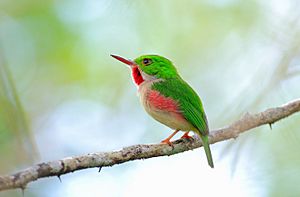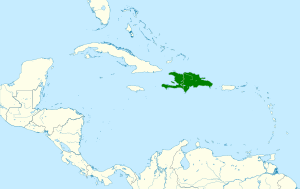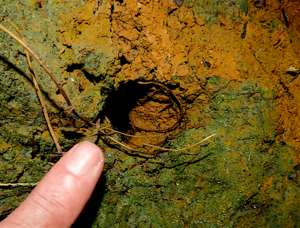Broad-billed tody facts for kids
Quick facts for kids Broad-billed tody |
|
|---|---|
 |
|
| Conservation status | |
| Scientific classification | |
| Genus: |
Todus
|
| Species: |
subulatus
|
 |
|
The broad-billed tody (Todus subulatus) is a tiny, colorful bird found only on the island of Hispaniola. It's one of two 'tody' birds living there, the other being the narrow-billed tody.
These birds are known for their bright green feathers, pink sides, and a striking red throat. They live in drier areas, usually below 1700 meters (about 5,600 feet), and don't like wet rainforests. Broad-billed todies stay in one small area their whole lives and don't migrate. You'll often see them hopping along branches, using their long bills to catch insects among the leaves.
They make a whistling sound as their main call. If a predator comes near, they make a trilly, chattering noise. They can also make a rattling sound by quickly moving air through their feathers. Their breeding season is from April to July. The female lays one clutch of one to four eggs. The baby birds grow up in about three weeks and then fly off to find their own space. The broad-billed tody is not an endangered species, so it's listed as "least concern" by the IUCN.
Contents
What Does the Broad-billed Tody Look Like?
The broad-billed tody is a small, round bird with a short tail. It has bright green feathers on its back, head, and wings. Its chest is plain white with a hint of yellow. It has a bright red throat, light pink sides, and yellow under its tail. Its eyes are slate-colored.
This bird has the widest bill of all the tody family, about 0.6 centimeters (0.24 inches) wide and 2.1 centimeters (0.83 inches) long. The top part of its bill is black, and the bottom part is red. Its feathers are short and rounded, not designed for long flights.
An adult broad-billed tody is about 11.5 centimeters (4.5 inches) tall and weighs around 7.5 grams (0.26 ounces). This makes it the largest bird in the Todus group. Male and female todies look almost the same. Young todies, called juveniles, don't have the red throat. Instead, their throats are pale yellow with a bit of red, and their chests have gray streaks. Their bills are also shorter.
Tody eggs are the smallest eggs among the Coraciiformes bird group. They are about 1.6 centimeters (0.63 inches) by 1.4 centimeters (0.55 inches) and weigh about 1.4 grams (0.05 ounces). The eggs are shiny white. They often get a reddish tint from dirt or a rosy color from the large orange-red yolk inside. This yolk helps them during their unusually long incubation time.
Where Do Broad-billed Todies Live?
The broad-billed tody lives only on the island of Hispaniola, which is shared by the Dominican Republic and Haiti. It shares the island with the narrow-billed tody. However, these two species usually live in different areas. They only meet in certain pine forests and mangrove swamps.
Broad-billed todies mostly live in low areas, from sea level up to 1700 meters (about 5,600 feet). They are more common in the Dominican Republic than in Haiti. They prefer dry places like low-land scrubs, desert-like areas with lots of cacti, and shaded coffee plantations. Even though they are tropical birds, they rarely live in dense rainforests and don't like wet conditions.
These birds do not migrate. They stay in the same small area their whole lives. During the breeding season, a pair will stay in their territory. In other months, they might look for food a little further away. Sometimes, they might even join a mixed group with narrow-billed todies for a short time. When breeding season starts again, they return to their original territory and keep it year after year. Young todies also don't travel far when they leave the nest. They usually find their own territory just a few kilometers away from where they were born.
How Do Broad-billed Todies Behave?
How Do They Reproduce?
Like other Coraciiformes birds, broad-billed todies dig burrows in dirt banks to make their nests. These burrows can be as deep as 60 centimeters (2 feet). Both male and female todies help dig the burrows, starting as early as September and continuing until June.
The breeding season runs from April to July. It begins with the male trying to impress the female. He might chase her in the air, doing flips and tumbles, while she chases him back. He might also hop around on branches, looking excited, and fluff up his feathers.
A very important part of their courtship is the 'flank display'. The male puffs up his pink feathers on his sides. At the peak of his display, he will puff up completely, looking like a round green puffball with no wings. His pink flank feathers will seem to spread over his back. The male with the most pink feathers that extend over his back is usually the most attractive to the female. Finally, the male will also flick his wings to make a 'rattling' sound. This is a special courtship behavior unique to todies.
Broad-billed todies are usually monogamous for one season. This means that once a pair forms, they typically stay together until the end of the breeding season. However, sometimes they might have more than one mate or lay more than one clutch of eggs.
Female todies usually lay one clutch of one to four eggs per season. The eggs take about two to three weeks to hatch. Both parents help incubate the eggs, but the female spends more time on them. Broad-billed todies are considered "inattentive" parents because they spend less than a quarter of their daylight hours incubating the eggs. The parents don't have a special greeting when they return to the nest and are mostly quiet when they are with their young.
However, when it comes to feeding their young, broad-billed todies are very hardworking. One study recorded 420 feedings a day for a nest with three chicks! This is more than any other insect-eating bird. Once the nestlings are born, they stay in the nest for another two to three weeks until they are ready to leave. After they leave, the parents separate, and the young birds survive on their own.
What Sounds Do They Make?
The broad-billed tody is a very talkative bird. It constantly makes noise and bobs its body while on branches. Their main sound is a whistle, which sounds like a steady terp, terp, terp without changing speed or pitch.
When a broad-billed tody sees a predator, a rival bird, or feels aggressive, it makes a "trilly, chattering" sound. They also make unusual guttural sounds, which don't sound like a typical call. These are most likely used during the breeding season. Todies have the simplest range of sounds of all birds.
Besides vocal sounds, they can make a rattling noise with their wings. They do this by quickly passing air through their feathers. The sound is like quickly running your finger across a comb. This wing-rattling is heard most often during the breeding season.
What Do They Eat?
Broad-billed todies eat insects and need a lot of food all year round. Their diet includes about fifty different insect families. They mostly eat grasshoppers, crickets, beetles, moths and butterflies, flies, and cockroaches.
They also eat certain fruits from specific plant families, as well as small vertebrates like tiny anole lizards.
To catch prey, the broad-billed tody uses a special technique called the "underleaf-sally." The tody sits on a branch with its eyes and bill pointing upward, looking for prey on the underside of leaves. In a quick, jerky movement, the tody jumps up in a curved path and catches the prey in mid-air. It then lands on another branch or further down the same branch without stopping.
Since it lives in dry areas, the broad-billed tody also uses the "Sally-Pounce." This is when it snaps prey from the top of leaves as it swoops downwards from its perch. Of all the todies, the broad-billed tody hunts at the highest height, usually about 3.1 meters (10 feet) off the ground.
When broad-billed todies and narrow-billed todies are together in pine forests, the broad-billed tody will hunt much higher, about 5.2 meters (17 feet) off the ground. These broad-billed todies will fly into more open areas of the trees and catch larger prey. They also use wider, more horizontal movements to catch prey, instead of short, jerky ones.
How Are Broad-billed Todies Protected?
The IUCN Red List says the broad-billed tody is a least-concern species. This means it's not currently threatened. The species lives in a large area on Hispaniola, estimated to be 121,000 square kilometers (about 46,700 square miles).
While the population seems to be decreasing, it's not happening fast enough to be considered threatened. Human activities have actually helped the broad-billed tody in some ways. For example, building ditches and trail sides has created the dirt banks that todies like for digging their burrows. Also, coffee plantations grown under tree canopies provide more shelter and food for them.
However, some coffee companies have found that growing coffee directly in the sun is cheaper, even if the coffee is lower quality. This, along with the use of pesticides near hotel resorts, has led to the destruction of the broad-billed tody's habitat. To help protect this species, we need to protect wooded areas and stop deforestation. Encouraging their population growth in wooded areas would be simple. It would just require returning to canopy-grown coffee plantations and providing man-made dirt banks for them to nest in.
Images for kids
See also
 In Spanish: Barrancolí picogrueso para niños
In Spanish: Barrancolí picogrueso para niños





